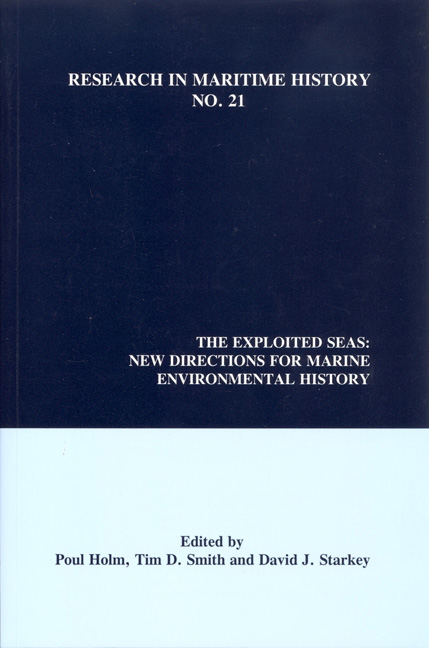Book contents
- Frontmatter
- Contents
- About the Editors
- Contributors
- “Introduction”
- Contributions
- “The Newfoundland Fisheries, c. 1500-1900: A British Perspective”
- “Testing Ecological Models: The Influence of Catch Rates on Settlement of Fishermen in Newfoundland, 1710-1833”
- “Nineteenth-Century Expansion of the Newfoundland Fishery for Atlantic Cod: An Exploration of Underlying Causes”
- “Status and Potential of Historical and Ecological Studies on Russian Fisheries in the White and Barents Seas: The Case of the Atlantic Salmon (Salmo Salar)”
- “The Danish Fisheries, c. 1450-1800: Medieval and Early Modern Sources and Their Potential for Marine Environmental History”
- “Historical Approaches to the Northern California Current Ecosystem”
- “Potential for Historical-Ecological Studies of Latin American Fisheries”
- “The South African Fisheries: A Preliminary Survey of Historical Sources”
- “The Potential for Historical Studies of Fisheries in Australia and New Zealand”
- “Examining Cetacean Ecology Using Historical Fishery Data”
“Examining Cetacean Ecology Using Historical Fishery Data”
from Contributions
- Frontmatter
- Contents
- About the Editors
- Contributors
- “Introduction”
- Contributions
- “The Newfoundland Fisheries, c. 1500-1900: A British Perspective”
- “Testing Ecological Models: The Influence of Catch Rates on Settlement of Fishermen in Newfoundland, 1710-1833”
- “Nineteenth-Century Expansion of the Newfoundland Fishery for Atlantic Cod: An Exploration of Underlying Causes”
- “Status and Potential of Historical and Ecological Studies on Russian Fisheries in the White and Barents Seas: The Case of the Atlantic Salmon (Salmo Salar)”
- “The Danish Fisheries, c. 1450-1800: Medieval and Early Modern Sources and Their Potential for Marine Environmental History”
- “Historical Approaches to the Northern California Current Ecosystem”
- “Potential for Historical-Ecological Studies of Latin American Fisheries”
- “The South African Fisheries: A Preliminary Survey of Historical Sources”
- “The Potential for Historical Studies of Fisheries in Australia and New Zealand”
- “Examining Cetacean Ecology Using Historical Fishery Data”
Summary
Abstract
Historicalfisheries data have been used to examine aspects of the ecology of many cetacean species. Examples are discussedfor three populations of whales: eastern North Pacific gray whales, North Atlantic long-finned pilot whales and North Atlantic humpback whales. Reconstructions of historical gray whale populations have improved understanding of population size relative to pre-exploitation sizes but have also suggested the possibility of long-term ecological change. Changes in the size composition of pilot whales indicate long-term fluctuations in production of young whales, implying greater vulnerability to ecological and environmental changes than is often assumed for top predators. Changes in the spatial distribution of humpback whales on breeding grounds over time have suggested differential recovery of components of populations or, alternatively, major shifts in the location of breeding grounds. There is potential to resolve some of these issues through the systematic analysis of historical sources, notably whaling logbooks and governmental records, through the examination of historical environmental sources, and through the interpretation of evidence from archeological investigations.
Introduction
Whalers have recorded various aspects of whaling operations and catches in ships' logbooks. Such information has been used with commercial and governmental records of the numbers of whaling voyages and fishery production to determine levels of catch and fishing effort. In some shore-based fisheries, written records were kept of individual whales in order to regulate the distribution of catches. Further, aboriginal catches of several species of whales have been inferred from archival and archeological records. Systematic information can often be constructed from such historical material even though the reliability and consistency of the sources vary greatly. This technique has been used to estimate historical abundances, to explore spatial distribution patterns and to examine changes in population productivity.
Several attempts have been made to use data extracted f r om such sources to reconstruct historical population sizes. Two approaches have been used, both motivated by a need to determine the effects of harvesting. One approach backcalculates historical population size from current estimates of population size, taking account of total catches and population productivity. This requires reliable estimates of historical catches and current abundance, and knowledge of the species ‘ biology. Methods for measuring current population size based on sighting surveys and on sight-resight studies have been developed, and these have provided reasonably precise estimates in some cases.
- Type
- Chapter
- Information
- The Exploited SeasNew Directions for Marine Environmental History, pp. 207 - 214Publisher: Liverpool University PressPrint publication year: 2001



